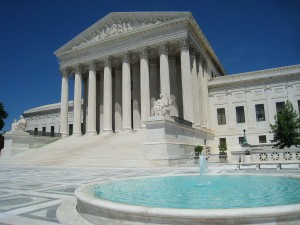Why Pick Federal Appeal Lawyers: Proven Strategies for Successful Appeals
Why Pick Federal Appeal Lawyers: Proven Strategies for Successful Appeals
Blog Article
Demystifying the Refine of Federal Appeals: What You Need to Know
Navigating the intricate world of federal allures can typically appear like going across uncharted waters for those unknown with the procedure. Recognizing the subtleties of appellate court jurisdiction, the complexities of submitting a notice of appeal, presenting a compelling brief, and making an influential dental argument are crucial elements that can considerably impact the outcome of a situation. By untangling the layers of intricacy surrounding federal appeals, people can get a more clear understanding right into the devices that govern this critical point of the legal system.
Understanding Federal Appeals Process
Looking into the elaborate realm of the government appeals procedure unveils a methodical and organized trip via the judicial system. Federal allures serve as a crucial mechanism for evaluating choices made by reduced courts. Comprehending this procedure is important for any person entailed in legal procedures at the government degree.
The process generally begins with a celebration dissatisfied with a reduced court's judgment submitting a notice of charm. This causes a review by a higher court, where a panel of courts analyzes the lawful disagreements provided by both parties. Briefs describing the legal reasoning behind each celebration's position are submitted, and oral arguments might be heard to make clear intricate problems.
The appellate court's choice is based on a complete evaluation of the lower court's process and the disagreements provided. The courts do not focus but reconsider realities on whether legal errors took place that impacted the lower court's decision. When the appellate court reaches a choice, it can verify, reverse, remand, or customize the reduced court's ruling, giving clearness and finality to the legal conflict. Recognizing this process is vital for navigating the intricacies of government allures properly.
Appellate Court Territory Explained
Appellate court jurisdiction refers to the range of instances that a specific appellate court has the power to assess and make a decision upon. Unlike trial courts that listen to cases for the initial time, appellate courts are limited to reviewing choices made by reduced courts.
Appellate courts have territory over certain kinds of cases, generally those entailing legal errors, procedural problems, or concerns of law as opposed to valid disagreements. The jurisdiction of appellate courts is usually outlined in laws and laws that regulate the court system. Comprehending appellate court territory is important for events associated with the appeals procedure as it figures out whether an instance is eligible for testimonial and the extent to which the appellate court can interfere in the lower court's decision.
Declaring a Notice of Charm
The first step in starting the government charms process includes filing a Notification of Charm with the appropriate appellate court. This critical document formally informs the court and the other parties entailed in the case that the appealing party means to seek a testimonial of the reduced court's choice. Submitting a Notice of Allure is a strict procedural demand that establishes the appellate procedure moving.
When preparing the Notice of Charm, it is necessary to make certain conformity with the specific policies and standards of the relevant appellate court. federal crime attorney. The record has to commonly consist of info such as the instance name, the lower court's name, the date of the judgment being appealed, and a concise statement showing the premises for the allure

Instruction and Dental Disagreement
In the appellate procedure, presenting written briefs and involving in oral arguments play essential duties in advocating for the appealing event's setting before the appellate court. Briefs are detailed lawful files that detail the parties' arguments, legal authorities, and evaluation sustaining their settings. These composed submissions supply the court with an in-depth understanding of the facts of the situation, the pertinent legislation, and why the appealing celebration believes the reduced court's choice ought to be rescinded.
Following the submission and review of the briefs, dental disagreements supply the events an opportunity to further clarify their settings, attend to any type of concerns the appellate judges may have, and highlight bottom lines from their written briefs. Oral disagreements are a possibility for the attorneys to encourage the judges through verbal campaigning for and responses to queries from the bench.
Both the composed briefs and dental debates are critical components of the appellate process, enabling celebrations to offer their case thoroughly and compellingly prior to the appellate court. - federal appeal lawyers
Getting the Appellate Court Choice
Upon conclusion of dental arguments and entry of written briefs, the following essential phase in the appellate procedure includes awaiting the definitive ruling from the appellate court. This duration of expectancy can be full of a mix of stress and anxiety and hope for events associated with the allure. The appellate court's decision is usually provided in a composed layout and details the court's final thoughts on the legal problems provided, the thinking behind their choice, and the judgment provided. The time framework for receiving the appellate court's choice can vary, however courts make every effort to supply prompt resolutions. When the choice is released, parties must very carefully evaluate the court's ruling to understand the end result and figure out any additional steps that might be essential. Whether the appellate court attests, reverses, or remands the reduced court's decision, understanding the ramifications of the ruling is crucial for all parties associated with the appellate procedure. For that reason, immediately examining and understanding the appellate court's choice is necessary in browsing the following steps in the legal process.
Verdict
Finally, the federal allures procedure is a complicated yet vital action in seeking justice. Understanding the appellate court territory, filing a notification of charm, preparing briefs, and providing dental debates are all important elements of this procedure. Eventually, getting the appellate court choice can offer quality and resolution to legal disputes. It is very important to browse the federal allures process with persistance and attention to detail to accomplish a reasonable end result.
As we progress from recognizing the government charms process to dissecting the intricacies of appellate court jurisdiction, an essential element comes to light pertaining to the authority and limits of these greater courts in the lawful landscape. Appellate court territory refers to the scope of instances that a specific appellate court has the power to choose and examine upon. Unlike test courts that listen to instances for the very first time, appellate courts are restricted to assessing decisions made by reduced courts. Understanding appellate court territory is crucial for parties involved in the appeals procedure as it determines whether a situation is eligible for evaluation and the degree to which the appellate court can interfere in the lower court's decision.

Report this page